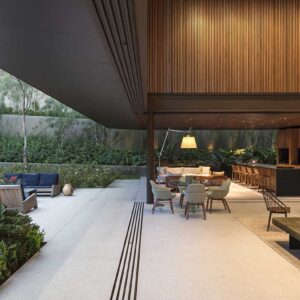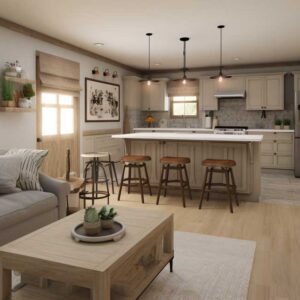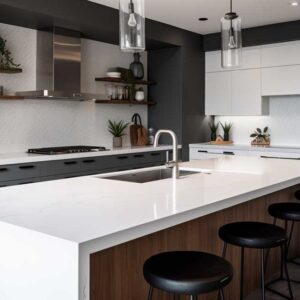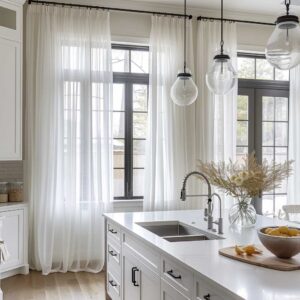Embracing a modern open kitchen design in your home is about more than just following a trend; it’s about creating a space that is both functional and stylish, blending the boundaries between cooking and living areas. This design approach caters to a more interactive and social kitchen experience, reflecting contemporary lifestyles where the kitchen is not just a place for preparing meals but a central hub for family and social gatherings. In this article, we explore the essence of modern open kitchen design and how you can master this style in your home.
Elegance Meets Function in Modern Open Kitchen Design




In the realm of interior design, the kitchen has always held a place of prominence, but never has it been as central to the home’s aesthetic and functional narrative as in the concept of the modern open kitchen design. This design philosophy is not just a fleeting trend; it represents a fundamental shift in how we perceive and interact with our living spaces. The open kitchen design is a testament to the evolving dynamics of contemporary lifestyles, where the kitchen transcends its traditional role and becomes a multifunctional hub.
At the heart of this transformation is the integration of elegance and functionality. Traditional kitchens, often secluded and utilitarian, have given way to spaces that are both visually appealing and highly practical. The modern open kitchen blurs the lines between cooking and living areas, fostering an environment of inclusivity and openness. This seamless transition from kitchen to living space is achieved through thoughtful design elements that balance aesthetics with practicality.
One of the most striking features of such kitchens is the use of clean lines and uncluttered surfaces. Minimalism plays a key role here, emphasizing space and openness. Cabinets and storage units are designed to be sleek and unobtrusive, often featuring handleless doors and integrated appliances that maintain the streamlined look. The choice of materials also reflects this blend of elegance and function. High-quality materials like quartz, granite, and hardwood are popular for their durability and beauty, making them ideal for a kitchen that’s both a workspace and a showpiece.
Central to the modern open kitchen is the island, a versatile piece that epitomizes the blend of form and function. The kitchen island often serves multiple purposes – as a prep area, dining space, and a social hub where people can gather and interact. Equipped with modern amenities like built-in sinks, cooktops, and storage solutions, the island becomes a focal point of the kitchen, marrying its utilitarian purpose with a sense of welcoming openness.
Lighting too plays a pivotal role in these kitchens. The use of ample natural light, supplemented by well-placed artificial lighting, enhances the sense of space. Large windows, often extending from the countertop to the ceiling, invite daylight to illuminate the kitchen, making it feel airy and spacious. The strategic placement of artificial lights – under cabinet lights, pendant lights over the island, and recessed ceiling lights – ensures that the kitchen is well-lit, functional, and aesthetically pleasing, regardless of the time of day.
The color palette in modern open kitchen designs also contributes to the overall elegance. Neutral colors like whites, grays, and beiges are popular for their ability to create a sense of calm and spaciousness. These colors work harmoniously with natural materials like wood and stone, creating a warm and inviting atmosphere. Bold colors and textures are often used as accents – in backsplashes, countertop appliances, or decorative elements – adding a personal touch and breaking the monotony of neutral tones.
Beyond the aesthetic appeal, the modern open kitchen is designed with ergonomics in mind. The layout is thoughtfully planned to ensure ease of movement and accessibility. The placement of appliances and work areas follows the principles of the kitchen work triangle, optimizing the flow between the refrigerator, stove, and sink. This ergonomic design reduces the effort and time spent on kitchen tasks, making cooking and cleaning more efficient and enjoyable.
The modern open kitchen design also reflects a broader cultural shift towards more social and interactive lifestyles. With the kitchen opening up to the living and dining areas, it becomes a space where cooking and socializing can coexist. This layout encourages family members and guests to interact with the person cooking, making meal preparation a communal and inclusive activity. It’s a space where children can do their homework at the island while a parent prepares dinner, where friends can gather for a casual meal, and where significant moments are shared.
In conclusion, the modern open kitchen design is a harmonious blend of elegance and functionality. It redefines the kitchen from a purely utilitarian space to a central, multifunctional hub of the home. By integrating clean lines, open spaces, thoughtful lighting, and ergonomic design, these kitchens not only cater to the demands of modern living but also create an atmosphere of warmth and inclusivity. As the heart of the home, the modern open kitchen is a space that embodies the aesthetic and practical aspirations of contemporary interior design.
Modern Open Kitchen Design: A Blend of Light and Space




The concept of modern open kitchen design represents a paradigm shift in the architectural and interior design landscapes, especially in how we interact with the most frequented space in our homes: the kitchen. This design philosophy extends beyond mere aesthetics, encapsulating a lifestyle that values openness, light, and spatial harmony. It is a response to the evolving needs of modern living, where the kitchen is not merely a place for culinary endeavors but a versatile, vibrant, and inclusive part of the home.
Central to this philosophy is the harmonious blend of light and space, which transforms the kitchen into an area that is both functional and inviting. The interplay of these elements creates an environment that is not just conducive to cooking but also encourages social interaction and relaxation. The emphasis on open space in modern kitchen designs is not just about physical dimensions but also about the perception of space. By minimizing barriers and adopting an open layout, these kitchens feel larger, more fluid, and more connected to the rest of the home.
The strategic use of light is crucial in enhancing this sense of openness. Natural light plays a dominant role, with large windows or skylights becoming a common feature in modern open kitchens. These architectural elements not only flood the space with daylight but also establish a visual connection with the outdoors, extending the perceived boundaries of the kitchen. During the night, or in kitchens with limited access to natural light, artificial lighting becomes vital. A combination of ambient, task, and accent lighting is employed to illuminate the kitchen evenly, highlight key areas, and create a warm and welcoming atmosphere.
In the realm of modern open kitchens, the choice of color palette and materials also contributes significantly to the feeling of space. Light, neutral colors dominate these designs, with shades of white, beige, and light gray being popular choices. These hues reflect light, making the space appear brighter and larger. The use of reflective surfaces, such as high-gloss cabinets and stainless-steel appliances, further amplifies this effect. In contrast, darker tones and natural textures, such as wood and stone, are used selectively to add depth and warmth, preventing the space from feeling too sterile.
The layout and organization of the kitchen play a pivotal role in maximizing both light and space. Open shelving, glass-front cabinets, and sleek, integrated appliances reduce visual clutter, allowing the eye to move freely across the room. The kitchen island, a staple in modern open designs, serves as a multifunctional centerpiece. It provides additional workspace and storage while acting as a social hub where family and guests can gather. This central feature bridges the gap between the kitchen and adjacent living areas, further reinforcing the open concept.
In addition to its aesthetic and spatial benefits, the emphasis on light and space in modern open kitchen designs has practical implications. A well-lit kitchen is essential for food preparation, enhancing safety and efficiency. The open layout facilitates better air circulation, reducing cooking odors and heat buildup. It also allows for more flexible movement and interaction within the space, accommodating multiple users simultaneously without feeling cramped.
The social aspect of these kitchens cannot be overstated. As the barriers between cooking and living areas are removed, the kitchen becomes a place of congregation and conversation. It becomes a space where cooking is not just a solitary task but an opportunity for interaction and engagement with others. This layout fosters a sense of community and togetherness, making the kitchen the heart of the home in a literal and figurative sense.
To conclude, the modern open kitchen design, with its emphasis on the blend of light and space, represents a thoughtful response to contemporary lifestyle needs. It is a design that celebrates openness and connectivity, inviting the outside in and encouraging a more communal and interactive way of living. Through clever use of layout, lighting, color, and materials, these kitchens offer a space that is not just a place for cooking but a central, vibrant part of the home. It is a testament to the idea that good design can enhance not just our spaces but also our experiences within them.
Contemporary Charm in Modern Open Kitchen Spaces
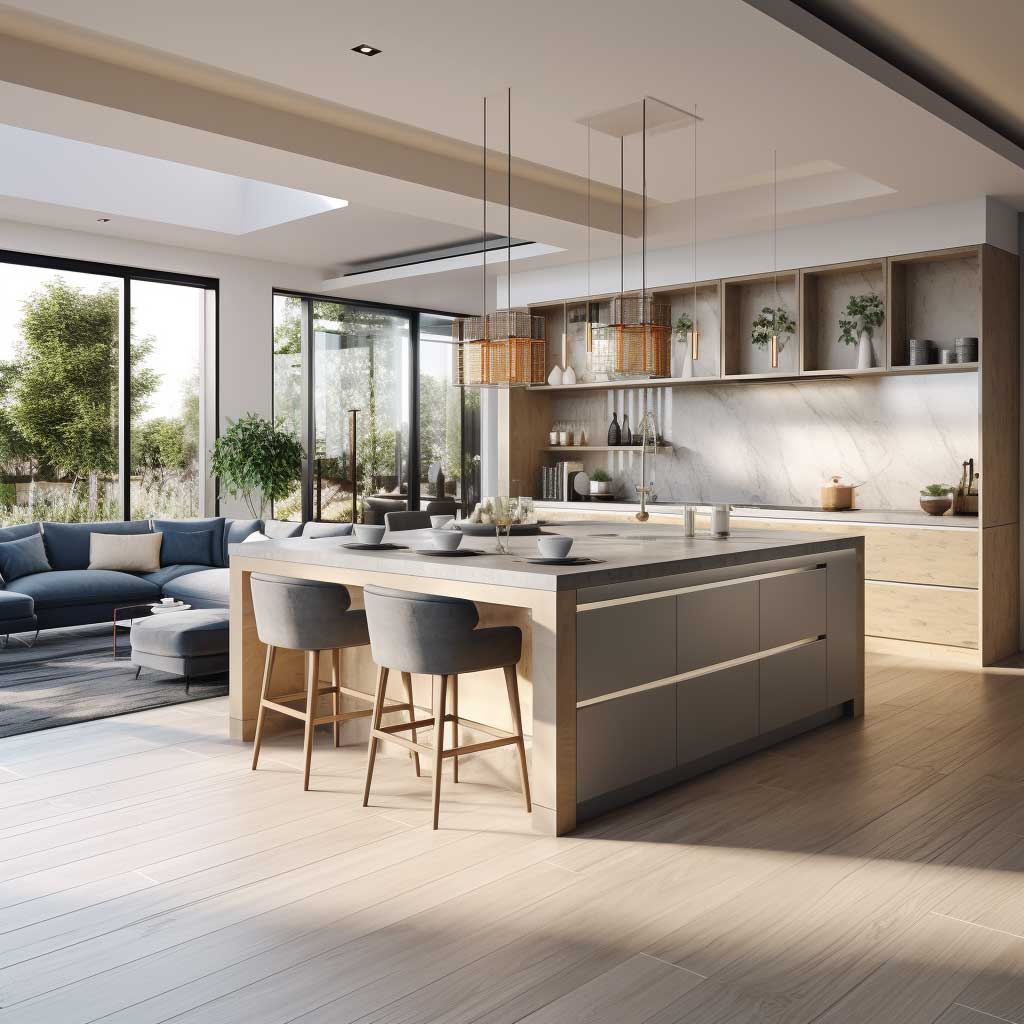



The evolution of the kitchen from a closed, purely functional space to a central, open area in modern homes reflects a significant shift in interior design and lifestyle preferences. Modern open kitchen designs stand as the epitome of contemporary charm, seamlessly integrating the kitchen with the living and dining areas to create a cohesive, multifunctional space. This approach not only enhances the aesthetic appeal of a home but also redefines the role of the kitchen, making it a vibrant, inclusive part of everyday life.
At the forefront of this design trend is the concept of contemporary charm, which combines the sleek, clean lines of modern design with the warmth and comfort of traditional spaces. This fusion creates kitchens that are not just visually striking but also welcoming and comfortable. The charm of these kitchens lies in their ability to balance form and function, offering a space that is both efficient for cooking and pleasant for socializing.
One of the hallmarks of contemporary open kitchens is the strategic use of layout and design elements to create an uninterrupted flow between the kitchen and adjacent areas. This open plan encourages interaction and socialization, allowing activities to transition seamlessly from cooking to dining to relaxing. The absence of walls or barriers fosters a sense of togetherness, making the kitchen an integral part of family and social gatherings.
The aesthetics of modern open kitchen designs are characterized by a minimalist approach, focusing on simplicity and understatement. Cabinetry with clean, straight lines, uncluttered countertops, and integrated appliances contribute to a sleek, unobtrusive look. This minimalism is not just a stylistic choice but also a functional one, as it allows for more efficient use of space and easier movement within the kitchen.
Material selection plays a crucial role in enhancing the contemporary charm of these kitchens. A combination of natural and synthetic materials is often used to achieve a balance between modernity and warmth. Elements such as stainless steel, glass, and concrete are juxtaposed with wood, stone, and textiles to create a space that feels both cutting-edge and homely. This blend of materials not only adds visual interest but also allows for a variety of textures and finishes, further enriching the kitchen’s design.
Color schemes in modern open kitchens tend to lean towards neutral palettes, with whites, grays, and blacks predominating. These colors create a clean, uncluttered backdrop, allowing architectural features and design elements to stand out. Accents in bolder colors or unique textures are often used to inject personality into the space, adding a touch of individuality without overwhelming the overall design.
Lighting is another critical aspect of these kitchens, with a focus on both functionality and ambiance. A combination of natural and artificial lighting is used to illuminate the space effectively. Large windows or glass doors allow for ample daylight, while a variety of lighting fixtures, such as pendant lights, under-cabinet lights, and recessed ceiling lights, provide targeted illumination. This thoughtful lighting design not only enhances the kitchen’s functionality but also contributes to its overall charm and atmosphere.
The modern open kitchen design extends beyond the physical layout and aesthetic choices; it also reflects a change in how we perceive and use our living spaces. These kitchens are designed to accommodate various activities, from cooking and eating to working and entertaining. They encourage a lifestyle that is more open, interactive, and social, reflecting the changing dynamics of contemporary homes.
In conclusion, the contemporary charm of modern open kitchen designs lies in their ability to merge functionality with style, efficiency with comfort, and modernity with tradition. These spaces are not just about cooking but about living, offering a versatile, inviting environment that enhances both the practical and social aspects of daily life. Through thoughtful design, careful material selection, and a focus on openness and light, modern open kitchens have redefined the heart of the home, making it a place where memories are made and shared.
The modern open kitchen design is more than just an aesthetic choice; it’s a lifestyle statement that combines beauty with practicality. It invites homeowners to reimagine their living spaces, encouraging interaction and openness while maintaining a sleek, contemporary look. By understanding the key elements of this design, such as minimalism, seamless integration with living spaces, and the smart use of light and color, you can create a kitchen that is not only a culinary workspace but also a focal point for social and family life.

